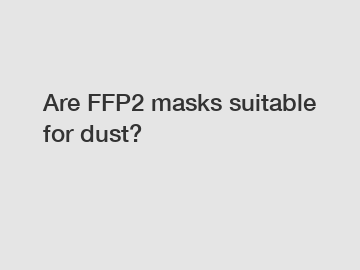Are FFP2 masks suitable for dust?
Are FFP2 masks suitable for dust? This question is often asked by individuals who are seeking the right type of mask for protecting themselves against dust particles in the air. In this article, we will discuss the suitability of FFP2 masks for dust, providing a comprehensive analysis of their effectiveness and the implications of using them.
FFP2 masks, also known as N95 respirators, are designed to filter out at least 94% of airborne particles, including pathogens such as viruses and bacteria. These masks are widely used in industries where workers are exposed to hazardous substances and fine particles, such as construction sites or manufacturing plants. However, their effectiveness in filtering out dust particles has been debated among experts.
To determine if FFP2 masks are suitable for dust, it is crucial to understand their filtration capabilities. Dust particles are typically larger compared to pathogens and can be filtered out by a mask with a lower filtration efficiency. While FFP2 masks are primarily designed for capturing smaller particles, they can still provide a certain level of protection against dust.

Various studies have been conducted to assess the efficacy of FFP2 masks in filtering out dust particles. One study, published in the Journal of Occupational and Environmental Hygiene, found that FFP2 masks were highly efficient in filtering out airborne dust particles with sizes ranging from 0.3 to 10 microns. This indicates that FFP2 masks can effectively trap most common dust particles found in various environments.
The use of FFP2 masks for dust protection has significant implications for individuals, especially those working in dusty environments. Dust particles, when inhaled, can cause respiratory issues, such as bronchitis or even lung diseases like silicosis. By wearing FFP2 masks, individuals can significantly reduce their exposure to harmful dust particles and mitigate the risk of developing respiratory ailments.
Furthermore, FFP2 masks are also beneficial for individuals with respiratory conditions, such as asthma or allergies. These masks can provide an additional layer of filtration, preventing allergens and irritants in the dust from triggering respiratory symptoms. Thus, FFP2 masks offer a practical solution for those seeking relief from dust-related respiratory issues.
In conclusion, FFP2 masks are suitable for dust protection due to their high filtration efficiency. While not specifically designed for dust, these masks can effectively capture a significant portion of airborne dust particles, providing individuals with adequate respiratory protection. The findings from various studies support the use of FFP2 masks in environments where dust exposure is a concern. By using FFP2 masks, individuals can safeguard their respiratory health and mitigate the risk of developing respiratory ailments caused by dust particles.
If you want to learn more, please visit our website ffp3 fold flat protective mask, China kn100 class duckbill shaped mask , kn100 class duckbill shaped masks.


